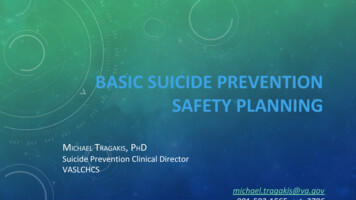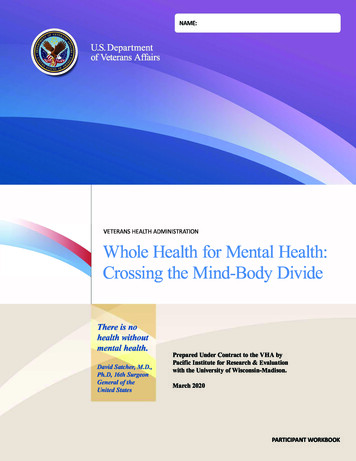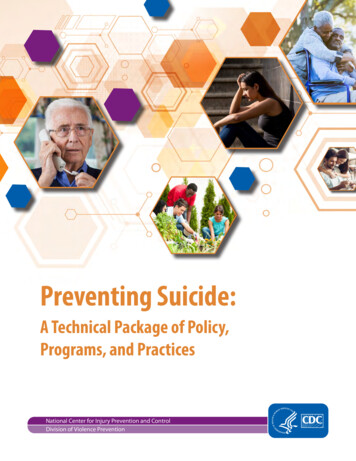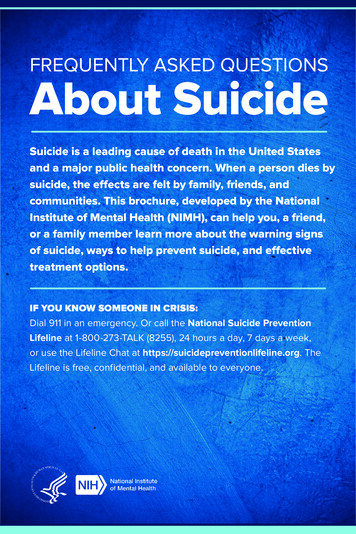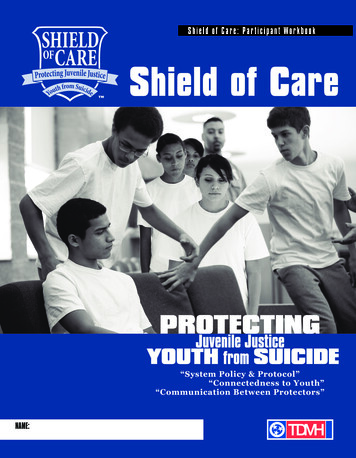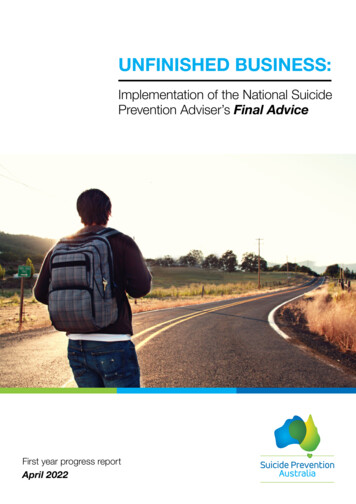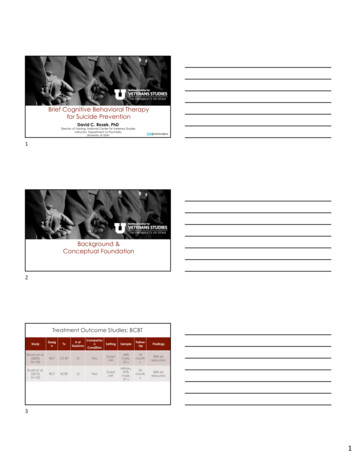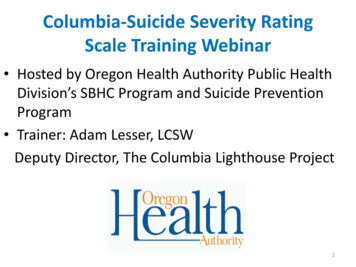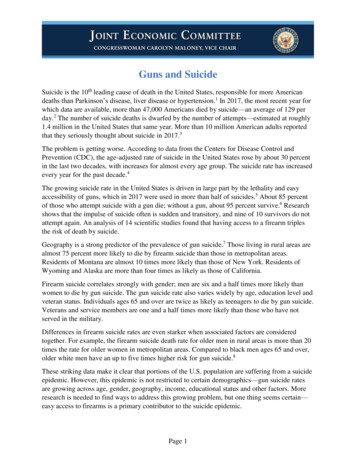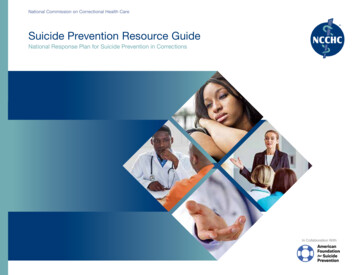
Transcription
National Commission on Correctional Health CareSuicide Prevention Resource GuideNational Response Plan for Suicide Prevention in CorrectionsIn Collaboration With
The National Commission on Correctional Health Care is a nonprofit 501(c)(3) organization workingto improve the quality of care in the nation’s jails, prisons, and juvenile detention and confinementfacilities. NCCHC establishes standards for health services in correctional facilities, operates avoluntary accreditation program for institutions that meet those standards, produces and disseminatesresource publications, offers a quality review program, conducts educational trainings and conferences,and offers a certification program for correctional health professionals. NCCHC is supported by themajor national organizations representing the fields of health, mental health, law and corrections.Each of these organizations has named a liaison to the NCCHC board of directors. For moreinformation, go to ncchc.org.The American Foundation for Suicide Prevention is dedicated to saving lives and bringing hope tothose affected by suicide. AFSP creates a culture that’s smart about mental health through educationand community programs, develops suicide prevention through research and advocacy, and providessupport for those affected by suicide. Led by CEO Robert Gebbia and headquartered in New York,and with a public policy office in Washington, DC, AFSP has local chapters in all 50 states with programsand events nationwide. Learn more about AFSP at afsp.org.Project 2025 is a high-impact, collaborative initiative developed by the American Foundation forSuicide Prevention, aimed at achieving the organization’s bold goal of reducing the annual suiciderate in the U.S. 20 percent by 2025.This publication represents the work of several national experts in suicide, mental health, corrections and correctional health care. The advice andsuggestions offered here are in no way guaranteed to prevent all suicides. Some ideas may not be applicable or feasible at all facilities.
Table of Contents2Forewords4Introduction6Assessment of Suicide Risk in Correctional Settings16Suicide Prevention and Treatment of Suicidal Behavior22 Suicide Identification and Prevention TrainingCurriculum Guide30References and Resources32 Facility Design: Creating a Physical EnvironmentThat Supports Well-Being34 Case Study: Hudson County Correctional Center,New Jersey36 Case Study: Middlesex Jail and House of Correction,Massachusetts38 NCCHC Standard B-05 Suicide Preventionand Intervention40Acknowledgments and ThanksTo find this resource online, visit ncchc.org/suicide-prevention-plan. 2019 National Commission on Correctional Health CareSuicide Prevention Resource Guide1
FOREWORDNational Commission on Correctional Health CareThe idea for the Suicide Prevention Resource Guide was conceived inAugust 2017 in a conference room in Chicago, where a group of mentalhealth experts convened with National Commission on Correctional HealthCare leadership for the inaugural Suicide Prevention Summit. The gatheredparticipants were remarkable not only because of their collective expertise,but also because they were, in many ways, competitors, representing fivemajor providers of correctional health care services. They came togetherdetermined to find solutions to a problem common to all correctional facilities.They discussed the complexities of suicide in corrections, shared theirchallenges and insights, considered possible process improvements, anddiscussed other ideas for keeping suicidal inmates safe. Most importantly,they agreed to keep meeting, collaborating and problem-solving.In 2015, the American Foundation for Suicide Prevention launched itsProject 2025, an ambitious initiative with the goal of reducing the annualsuicide rate 20% by 2025. The project’s focus on corrections as one of four key areas with potential to save the most lives created a natural synergy withNCCHC’s ongoing suicide prevention efforts. The next Suicide Prevention Summit, cosponsored by AFSP, brought back the original participants, plusthought leaders from jails, universities, departments of corrections and the federal government to brainstorm next steps and start drafting an action plan.The result is this Suicide Prevention Resource Guide, representing the collective knowledge of countless experts. The guide includes insight into assessingsuicide risk, promising practices and guidelines for treating at-risk individuals, and guidance on developing a training curriculum – all through the lens ofworking with justice-involved patients within a correctional setting.AFSP graciously supported this project financially, as well as provided perspective and subject-matter expertise. NCCHC provided our deep experiencein correctional health care and nationally recognized standards to guide practice, as well as editing and production services.The work of the AFSP–NCCHC partnership is not over. Together we will continue to work to reduce the incidence of suicide behind bars.Deborah Ross, CCHPChief Executive Officer (interim)2NCCHC – AFSPBrent Gibson, MD, MPH, CAE, CCHP-PChief Health Officer
FOREWORDAmerican Foundation for Suicide PreventionThe American Foundation for Suicide Prevention is the nation’s leadingsuicide prevention organization, and Project 2025 is our bold initiative aimedat reducing the national suicide rate 20% by the year 2025. As part of thisinitiative, we have identified the corrections system as one of four critical areasthrough which we can save the most lives in the shortest amount of time.According to the U.S. Department of Justice, suicide is the leading cause ofdeath in jails, and the suicide rate in prisons continues to increase. Incarceratedpeople are particularly vulnerable to suicide for a variety of complex reasons.As such, we are partnering with the National Commission on CorrectionalHealth Care to create a comprehensive guide to preventing inmate suicidein jails and prisons.This guide provides a road map for navigating the complexities of suicideprevention in correctional settings. Research tells us that people in times oftransition are at especially high-risk for suicide, and that there are particularly critical windows during which we can provide effective, life-saving suicideprevention interventions. Working together with NCCHC, we can educate both correctional staff and health care professionals who work in the correctionalsystem about suicide risk and how to identify and care for the suicidal inmate-patient.This Resource Guide is the result of the combined knowledge of our two organizations, and was developed with input from mental health experts from thenation’s largest jail and prison health care providers. Three areas have been identified as crucial for suicide prevention in a correctional setting – assessment,intervention, and training. In these pages, you will learn how to better identify and help inmates at risk for suicide, safely manage those identified as suicidal,and provide consistent, comprehensive training to all involved personnel.Suicide can be prevented. By working together, we will save lives.Robert GebbiaChief Executive OfficerChristine Moutier, MDChief Medical OfficerSuicide Prevention Resource Guide3
esignCase StudiesIntroductionSuicide is a profoundly solitary act. The response to it, however, must not be. Suicide prevention requires a coordinated, multifaceted team effort.Nowhere is that more true than in jails and prisons.Incarcerated men and women are a socially excluded population characterized by a multitude of personal and social problems and, often, mental healthor substance abuse issues. Those risk factors for suicide are compounded by confinement, leaving some people feeling overwhelmed and hopeless.Tragically, too many of them die by suicide as a means of ending what feels like inescapable pain.The goal of suicide prevention is to reduce risk before it becomes a crisis and, when necessary, defuse a crisis before it becomes fatal. The correctionalmental health professional’s role is to help at-risk individuals find better mental health, hope, and reasons for living, and thus avert tragic and preventablesuicides. That life-saving effort requires the cooperation, knowledge, observations and insights of the entire facility staff. Furthermore, suicide preventionis not a one-time event. It begins at intake and does not end until the individual returns to the community.Fortunately, understanding of suicide risks and warning signs specific to incarcerated populations is expanding. Effective prevention strategies andinterventions are being used today in correctional settings, and progress will continue to be made as knowledge continues to grow.Through the Suicide Prevention Resource Guide, the National Commission on Correctional Health Care and the American Foundation for Suicide Preventionhave joined forces to work toward reducing the incidence of suicide in jails and prisons. The guide focuses on three areas key to suicide prevention incorrections: assessment, intervention and treatment, and training. The aim is to educate the field on how to better identify and help inmates at risk for suicide,safely manage those identified as at high risk, and provide consistent, comprehensive training to all involved personnel.Combining NCCHC’s knowledge of correctional mental health care with AFSP’s expertise in suicide prevention represents a unique opportunity to developsolutions that can effect real change – and save lives. In its Project 2025, AFSP identified corrections as one of four critical areas with the highest potentialfor preventing suicide, with the goal of reducing the suicide rate 20% by the year 2025.Joining in the NCCHC–AFSP partnership are mental health experts serving some of the nation’s largest jail and prison systems, private health care providers,and leaders from within the corrections field – individuals who operate on the front lines of the suicide crisis and offer real-world perspective.The result of this partnership to date is this Suicide Prevention Resource Guide. NCCHC and AFSP are deeply indebted to the cadre of experts who contributedwriting, research, scholarship, review, critique, input, and wisdom to the resulting product.We hope this guide proves useful in your facility’s quest to prevent inmate suicide.(See page 40 for a complete list of acknowledgments.)4NCCHC – AFSP
While suicide isa profoundly solitaryact, suicide preventionrequires a coordinated,multifaceted effort.Suicide Prevention Resource Guide5
esignCase StudiesAssessment of Suicide Risk in Correctional SettingsUnderstanding Suicide RiskMany people have thoughts of suicidewithout acting on those thoughts.Fewer people make attempts, anddeaths by suicide are less frequent.Preventing suicide requires ongoing assessment to identifypatients who are at heightened risk and need intervention.Only by identifying those individuals can resources beappropriately directed to target interventions and save lives.In correctional settings, however, valid and reliable suiciderisk assessment has remained elusive for a number ofreasons, many of which will be discussed here. There isno magic formula or definitive approach to suicide riskassessment, as understanding of this complex behavioramong a complex patient population continues to evolve.What follows are state-of-the-art recommendations basedon advancements in the science and consensus amongexperts.The goal of suicide prevention is toreduce risk for individuals before itbecomes a crisis. There are manybiological, psychological, social,and environmental factors that canlead to suicidal behavior. Somecontributors that may combine toincrease the possibility for suicidalbehavior over the course of one’slife include, but are not limited to:a mental health condition, includingalcohol and substance use disorders;a physical health condition or chronicpain; family history of mental healthconditions or suicide; head trauma,and early life trauma or abuse(physical or sexual).On top of lifetime risk factors, currentfactors may include life stressors;current alcohol and substance use;current mental and physical health,and access to care. Access to lethalmeans is the key factor leading todeath.6NCCHC – AFSPWhen an individual is in a suicidalcrisis, their thinking becomeslimited and less flexible, and they feeltremendous pain and desperation.In these moments, they don’t haveaccess to their usual coping abilities,and protective factors such as family,friends, religion, and hope may bestretched.Fortunately, tools and interventionsexist that can help to prevent suicide.They involve: treating mental healthconditions; developing a plan formanaging suicidal thoughts andbehaviors; and limiting access tolethal means. Suicidal crises comeand go, and research shows thatthe intensely painful moment ofpossible action is temporary, sobuying someone time to get throughit by limiting access to means,and helping them get through theimmediate crisis can save their life.Assessment: MoreThorough Than ScreeningScreening and assessment, whileboth important to identifyingindividuals at risk for suicide, are
not the same thing. That is animportant distinction, as the termsare often mistakenly interchanged.Screening is generally a one-timeevent used at intake for the earlyidentification of individuals atpotentially high risk for suicide.Screenings are usually brief, usesimple “yes/no” questions, and canbe administered by health careprofessionals or trained custody staff.Screening results do not definitivelydiagnose a specific condition ordisorder, but can indicate a needfor further evaluation or preliminaryintervention.Screening tools for suicide risk thathave been validated in the communityare available that can be used incorrectional settings with modification.(See box on page 11 for list ofvalidated screening tools.) They canbe used during the admission processto help identify immediate needsand in special situations, such asplacement in restrictive housing/segregation, following a court hearing,proximate to a transfer or a changein security status.Suicide Warning SignsTALKBEHAVIORExperiencingunbearable painBeing a burdento othersKilling themselvesWithdrawing fromactivitiesIncreased use ofalcohol or drugsGiving away prized possessionsIsolating fromfriends & familyFeeling trappedHaving noreason to liveSleeping too littleor too muchMOODDepressionLoss of interestAnxietyActing recklesslyLooking for a way to killthemselves, such assearching online formaterials or meansVisiting or calling peopleto say rg/signsAssessment, on the other hand,is an in-depth process involvinga comprehensive examinationconducted by a qualified mentalhealth professional (QMHP).Assessment is not a one-time event,but a process that should be ongoingthroughout the at-risk patient’sincarceration.An assessment includes a thoroughevaluation of the individual’s historyand functioning across multipledomains, providing a more completeclinical picture. Assessments assistin identifying key risk factors,including mental health conditionsor psychological problems and theirseverity, and aid in treatment planning.Assessments typically integrate resultsfrom multiple sources, includingpsychological tests, clinical interviews,behavioral observations, clinicalrecords, and collateral information.A comprehensive assessment ofsuicide risk includes sufficientdescription of the current behaviorand justification for the interventionsbeing provided to mitigate risk andmove the individual away from suicidalthoughts and behaviors.This section of the Suicide PreventionResource Guide focuses onassessment, as it is assessmentsthat inform health staff about thetargeted interventions required forthe individual patient.Suicide Prevention Resource Guide7
ng IncarceratedPopulationsJustice-involved individuals, as awhole, present certain characteristicsthat make suicide risk assessmentand intervention particularlycomplicated. To understand thosechallenges, it is important to understand the incarcerated population.Common risk factors are all toocommon. Research has identifiedcertain risk factors that heighten therisk for suicide. Those risk factorsare common and chronic amongincarcerated individuals, underscoringthe need to provide preventionstrategies for the entire incarceratedpopulation.Justice-involved patients oftenhave histories of trauma. Trauma isa risk factor for suicide. According tothe National Center for PosttraumaticStress Disorder, about 4% of menand 10% of women in the UnitedStates will develop PTSD sometimein their lives, while approximately 6%of male inmates and 21% of femaleinmates meet criteria for PSTD. Aneven larger number of incarceratedindividuals have been exposed totraumatic events, including domesticviolence, neglect, emotional abuse,physical abuse, assault, sexual abuse,and sexual assault. Among femaleinmates, staff have estimatedtrauma exposure as high as 90%.8NCCHC – AFSPReferencesDesignCase StudiesAbout “Suicide Watch” or PrecautionsPatients assessed as at current risk for suicide must be placed on alevel of suicide precautions consistent with their level of risk. All cellshousing suicidal inmates must be suicide-resistant. Decisions regardingthe removal of a patient’s clothing, bedding, possessions (e.g., books,slippers/sandals, eyeglasses) and privileges should be commensuratewith the level of suicide risk as determined on a case-by-case basisby the assessing qualified health care professional.If the health care professional determines that a patient’s clothingneeds to be removed for reasons of safety, the patient should alwaysbe issued a safety smock and safety blanket. All patients on suicideprecautions should be allowed access to a shower consistent withschedules in other special housing units. A safety mattress shouldbe issued to any patient on suicide precautions unless he/she utilizesthe mattress in ways in which it was not intended (e.g., attempting totamper with/destroy, utilize to obstruct visibility into the cell).Patients on suicide precautions should not automatically be locked down;they should be allowed all routine privileges (e.g., family visits, telephonecalls, out-of-cell exercise) commensurate with their security status.Finally, all patients on suicide precautions should be allowed to attendcourt/parole hearings unless exigent circumstances exist in which apatient is out of control and at immediate risk to self and others.A complicating factor is thatindividuals with histories of traumamay not easily engage in open andhonest discussions about theirthoughts and feelings, especiallywith people they do not know.Justice-involved patients canbe impulsive. Many incarceratedindividuals have antisocial traits,as expressed by their willingness toviolate the law, and many alsostruggle with substance use disorders.Common characteristics of peoplewith those challenges includeimpulsivity and recklessness.Impulsivity is marked by engagingin behavior without forethought.Recklessness is marked by engagingin behavior without consideration ofthe danger or consequences of one’sactions. Both result in unpredictableand often sudden dangerousbehaviors, including suicidal actions.It is difficult to assess risk in apopulation for whom impulses playa large part. As an example, a suiciderisk screening completed during thereception process may not identifythe risk factors that characterize animpulsive response to interpersonalconflict days later.Suicide Risk Assessment:A Process, Not an EventAt present, there are no knownvalidated suicide risk assessmentinstruments designed specificallyfor use in correctional settings.The principles and approachesdescribed below are based on ageneral population in the community.As such, they are a useful startingpoint for risk assessment ofincarcerated individuals, while notaddressing the unique challengesdiscussed.While each method provides afoundation for conducting suiciderisk assessment, additionalinformation is needed to develop anassessment process appropriate forincarcerated populations andcorrectional settings. Until a validatedcorrections-specific assessmentinstrument is developed, theseprinciples are to be used as guidelines.Each of these methods highlightsthat suicide risk assessment is aprocess, not an event; is multifaceted;
and requires information from multiplesources. These methods alsorely heavily on patient self-report,which can present challenges withcorrectional populations.Zero Suicide: The Zero Suicideinitiative describes three componentsof a full assessment and provides afoundation for treatment planning:1. Gather complete informationabout past, recent, and presentsuicidal ideation and behavior2. Gather information about thepatient’s context and history(e.g., mental and physical health,family mental health history,early trauma and abuse history,head injury)3. Synthesize that information intoa prevention-oriented suiciderisk formulation anchored in thepatient’s life contextCollaborative Assessment andManagement of Suicidality (CAMS):CAMS is an evidence-based, flexibleassessment and intervention modelbased on a process of collaborationbetween the clinician and the patient.The goal is to identify drivers ofsuicidal ideation and behavior alongwith reasons for living and reasonsfor dying to discuss ambivalenceabout suicide. This establishes abasis for collaborative solutions.It functions as a tool for bothassessment and intervention.Chronological Assessment ofSuicide Events (CASE): The CASEapproach involves exploring thechronology of suicidal ideation andbehavior with the patient and providesrecommendations for interviewingtechniques to help elicit disclosure ofsuicidal ideation. The CASE approachinvolves three tasks:1. Gathering information related tothe risk factors for suicide2. Gathering information relatedto the patient’s suicidal ideationand planning3. Making clinical decisions basedon those dataH.E.L.P.E.R: The H.E.L.P.E.R systemhas three phases: 1) collection ofdata (information about the patient),2) analysis of that data, and3) documentation. The H.E.L.P.E.Rsystem includes the following: Historical factors Environmental factors Lethality of the suicide thinkingand behaviors Psychological factors Evaluation of suicide risk potential Reporting of findingssuicidal desire, suicidal capability,suicidal intent, and mitigatingbuffers/connectedness. Suicidal desire- Suicidal ideation- Psychological pain- Hopelessness- Helplessness- Perceived burden on others- Feeling trapped- Feeling intolerably alone Suicidal capability- History of suicide attempts- Exposure to someone else’sdeath by suicide- History of/current violenceto others- Extreme agitation/rage- Available means of killingoneself- Currently intoxicated- Substance abuse- Acute symptoms of mentalillness Suicidal intent- Attempt in progress- Plan to kill self, method known- Preparatory behaviors- Expressed intent to die Buffers/connectedness- Immediate supports- Social supports- Planning for the future- Engagement with helper- Ambivalence for living/dying- Core values/beliefs- Sense of purposeNational Suicide PreventionLifeline: Under a grant from theSubstance Abuse and Mental HealthServices Administration, the NationalSuicide Prevention Lifeline developeda set of core principles and subcomponents for suicide risk assessmentthat includes four main areas to beprobed during an assessment:Suicide Prevention Resource Guide9
esignCase StudiesApproaches to AssessingSuicide RiskClearly, the process of assessingsuicide risk involves more thancompleting a simple questionnairewith the patient.When peoplemove beyond a suicidalcrisis or attempt, theytypically find ways toengage in theirlives.10NCCHC – AFSPBe collaborative, confident andcompassionate. The Zero Suicideinitiative emphasizes that screeningand assessment of suicide risk mustattend to more than just the instrument being used or the questionsbeing asked. The qualified health careprofessional conducting a clinicalinterview is encouraged to: Adopt a collaborative stance,reflecting empathy andgenuineness. Convey confidence that paincan be alleviated by alternativemeans and that the patient canbe empowered to use care andservices to do so. Treat the interview as an exploration of what has happenedto the patient, not as a task tocomplete or an examination ofwhat is wrong with the patient. Indicate that when people movebeyond a suicidal crisis orattempt, they typically find waysto engage in their lives. Morethan 90% of people who makea suicide attempt do not die bysuicide even upon long-termfollow-up. Express an understanding ofthe ambivalence in the patient’sdesire to die to relieve pain.Ensure reasonable privacyand confidentiality during thescreening and assessmentprocesses. Experience hasdemonstrated that it is not unusualfor an otherwise suicidal inmate todeny suicidal ideation whenquestioned in a physical environmentthat lacks privacy and confidentiality.The intake or reception area of anyjail or prison is traditionally chaoticand noisy, an environment wherestaff feel pressure to process a highnumber of inmates in a short periodof time. Two key ingredients foridentifying suicidal behavior – timeand privacy – are at a minimum.The ability to carefully assess thepotential for suicide by askingthe inmate a series of questions,interpreting their response (includinggauging the truthfulness of theirdenial of suicide risk), and observingtheir behavior is grossly compromisedby an impersonal environment thatlends itself to something quite theopposite. Efforts should be made toensure privacy and confidentiality(from other inmates and non-healthcare personnel) when conductingsuicide risk screening andassessments.
Maximize rapport and selfdisclosure. In The Practical Art ofSuicide Prevention, C.S. Shea identified the following approaches tohelp establish rapport and encourageself-disclosure on the part of thepatient: Ask for specific descriptionsof behavioral incidents, not thepatient’s opinions. Avoid judgmental or shameinducing questions by framingquestions in a manner that isconsistent with the patient’sexperience. Assume the existence of suicidalimpulses and ask about themdirectly, in a matter-of-fact tone. Frame questions regardingfrequency of behavior andideation in a manner that mayoverestimate their true frequency,so that the patient will respondwith a more accurate estimationof their frequency, rather thanminimizing them. Avoid blanket questions. Instead,ask about specific types ofsuicidal behavior and ideationseparately.But don’t rely solely on self-report.It is extremely important for a qualifiedhealth care professional (QHCP) tobalance patient self-report with thecollection of objective data relatedto the patient’s suicide risk using allinformation available to them.Screening and Assessment InstrumentsThe following list includes some of the screening toolsthat have been validated on community populations(not corrections): Columbia Suicide Severity Rating Scale(C-SSRS): Three versions are available for use.The “Lifetime/Recent” version supports inquiryinto a patient’s lifetime history of suicidal ideationand behavior as well as any recent suicidal ideationand/or behavior. The “Since Last Visit” version ofthe C-SSRS screens for suicidal ideation andbehavior since the patient’s last visit. The “Screener”version is a shortened form of the full version.Available at: cssrs.columbia.edu Suicide Behaviors Questionnaire – Revised(SBQ-R): This 4-item questionnaire includesquestions about suicidality over the lifespan aswell as future risk. It includes a scoring guideWhenever possible, previoustreatment information should bereviewed, along with objective datafrom staff observations and incidentreports, and direct observationof the patient during the clinicalinterview. Include family members,if possible, as people may conveytheir distress more directly to family.Include discussion of copingstrategies and other protectivefactors during the assessmentinterview. A critical ingredient to thesuicide risk assessment process (aswell as clinical rationale for dischargingthe patient from suicide precautions)is the development of a safety plan.with validated cut-scores. Available at:integration.samhsa.gov/images/res/SBQ.pdf Patient Health Questionnaire – 9 (PHQ-9):Used most often in primary care settings, thisnine-item questionnaire has been validated inthe identification of high-risk patients. Downloadfrom: /218The following assessment instruments have beenvalidated on community populations (not corrections)and are entirely self-report based: Beck Scale for Suicide Ideation: Available forpurchase at pearsonassessments.com/store Beck Hopelessness Scale: Available forpurchase at pearsonassessments.com/storeA safety plan includes warning signs,ways the person can distract themselves, who they can be with todistract themselves, people they candiscuss their distress with, professionals and how to contact them, howto limit access to lethal means, andreasons for living. While this is anintervention, the development of theplan provides a wealth of informationto support the assessment. A suicidalcrisis is not a good time to developa plan.One helpful instrument is the Reasonsfor Living Inventory, which assesseslife-maintaining beliefs. Areas ofpotential inquiry include the patient’s: In-cell activities Distress tolerance skills Emotion regulation skills Long-term goal orientation Relationships with cellmates orothers on the tier Relationships with supports inthe community Ability to ward off suicidal/selfinjurious impulses Ability to ask for help How the patie
mental health professional's role is to help at-risk individuals find better mental health, hope, and reasons for living, and thus avert tragic and preventable suicides. That life-saving effort requires the cooperation, knowledge, observations and insights of the entire facility staff. Furthermore, suicide prevention is not a one-time event.
